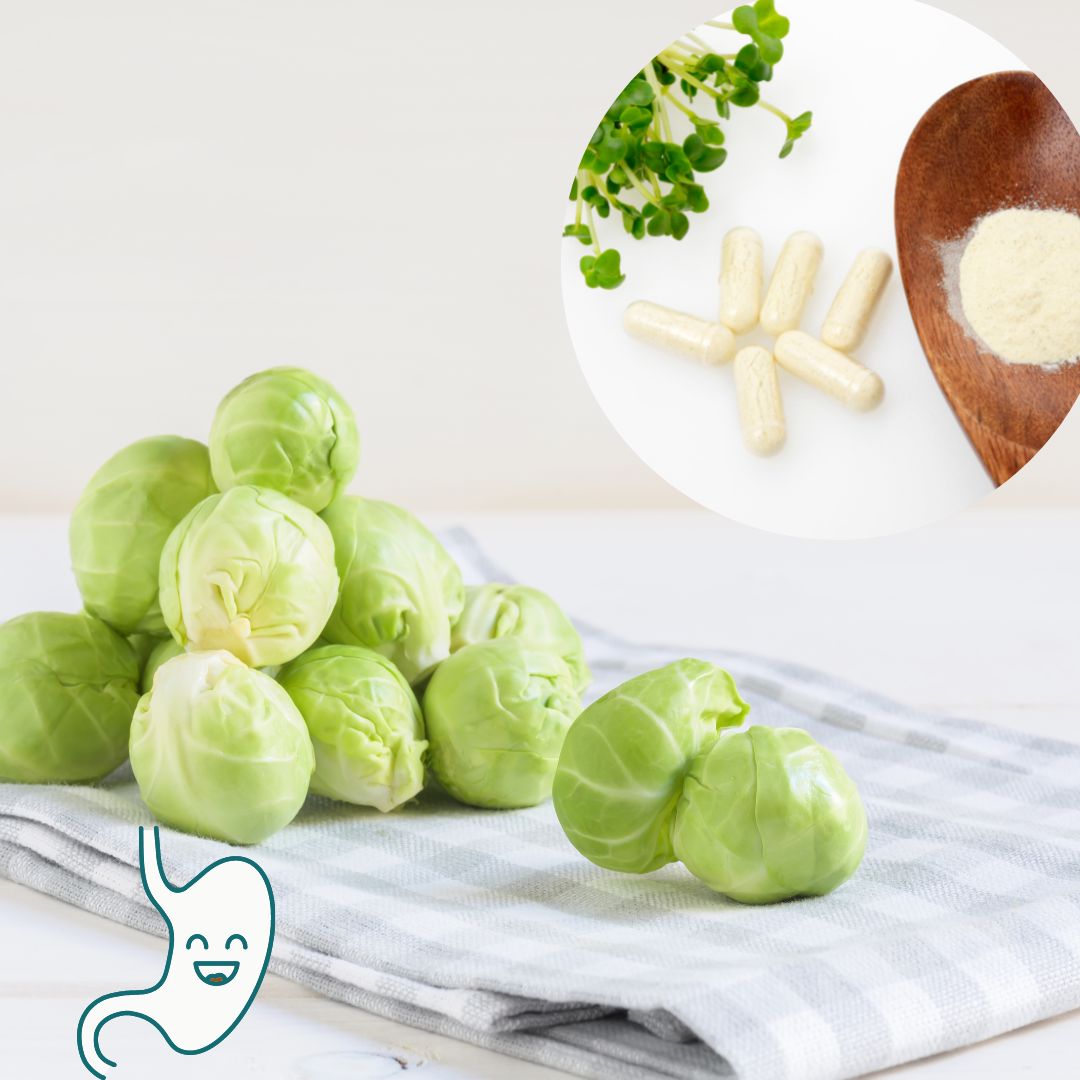This is one of my favourite supplements…
Sulforaphane is a natural chemical found in specific plants from the brassica family e.g. broccoli, cabbage, cauliflower, kale etc. and over the last few years there has been a bit of a buzz about it (its not the new kid on the block exactly but there is some interesting research coming out about its possible health benefits.
What is it?
It’s a compound that is rich in sulfur. Like most things in our body or in our food, we eat its inactive form – glucoraphanin, then when it comes in contact with an enzyme called myrosinase it turns into its active form. The only way for these 2 to ‘come together’ is when a plant is damaged (most of the beneficial compounds in foods come from plants that are damaged which produce these compounds to protect themselves from further damage). Why do we need to know this? Because if you are wanting sulforaphane from veggies then they need to be chopped or squished in order for the plant to release the myrosinase so it can then activate glucoraphanin into sulforaphane (think Linda Carter doing the spinny thing and turning into Wonder Woman – I know I am a child of the 70’s) (1)
Health benefits
There have been a LOT of studies done in a lab and on animals so the research on actual human beings is limited but it is growing. Whilst lab studies are really helpful for showing mechanisms behind the actions they don’t necessarily mean that those mechanisms work in the real world when there are lots of other things that can influence or prevent those actions.
The benefits so far seem to be:
- Sulforaphane may help prevent cancer (although this was using concentrated supplemental form NOT food) (2)
- It protects against cardiovascular disease by preventing damage to blood vessels and the heart. (3)
- It has been shown to reduce fasting blood glucose and glycated hemoglobin (HbA1c) in obese patients with dysregulated type 2 diabetes and suppresses glucos e production by the liver and may reduce liver disease as a result of hyperglycemia and diabetes type 2. (4)
- In another study (unfortunately just on rats) sulforaphane was shown to decrease oxidative damage and inflammation in the kidneys and blood vessels thereby reducing blood pressure. (5)
- There is also some promising research on autism (6) and brain injury recovery (7) (although again the studies have been on rats rather than humans).
- One of the reasons I love it is because of its benefits to gut health. It has been shown to reduce damage to the gut lining, helps balance gut bacteria and improves motility (movement). In one trial, 20g of broccoli sprouts improved constipation. (8)
- In my other favourite topic, hormone balance, sulforaphane shows promise in preventing or treating breast cancer by reversing estrogen‐induced metabolic changes (9) but clearly more research is needed. Some studies have shown that sulforaphane (or even broccoli itself) can help with oestrogen metabolism and balance (10) which is important in the prevention of oestrogen driven diseases and conditions.
The reasons why it is beneficial is because its:
- It is Anti-inflammatory
- It encourages the natural death of cells (when cells get damaged and they don’t die they can cause cancer in the long term)
- It supports the liver to detoxify (break down and make safe) anything that could be toxic to us in both phase 1 and phase 2 liver detoxification. It helps to stop damage in the liver when detoxification processes take place.
- It has also been shown to kill H.Pylori (which in high amounts is associated with stomach cancer). (1)
- One of the biggest ways that sulforaphane benefits is by behaving like a very mild pro-oxidant, in doing so it triggers a protein called Nrf2 which basically turns on over 1000 genes that are involved in antioxidant, anti-inflammatory and anti- cancer roles. It’s a bit like someone loud and obnoxious banging on your door (sulforaphane) telling you (Nrf2) to get out of bed because there is a fire and you need to get up and call 111 (the genes) to get the fire brigade, police and ambulance out (antioxidants, anti-inflammatory and anti-cancer compounds in the body).
Where do I find it?
Raw veggies (broccoli, cauliflower, kale, cabbage, Brussel sprouts) have the most with broccoli sprouts being the most abundant. Steaming lightly is the best way to ‘cook’ these veggies and not destroy the sulforaphane. The minute you boil, roast or microwave most of it will be killed.
My Top Tips
- Eat a veggie from the brassica family everyday (if you can tolerate it – if you can’t call me). Steam or blend or eat raw (think coleslaw or side salad).
- Try broccoli sprouts in your salads or in your smoothies – I love this company https://www.naked-sprouts.com/ or you could try and grow your own.
- Try a supplement. I have my favourites so let me know if you want to know what they are. This is one of the few supplements I do take myself.
References
- https://altmedrev.com/wp-content/uploads/2019/02/v15-4-352.pdf
- https://pubmed.ncbi.nlm.nih.gov/29977456/
- https://pubmed.ncbi.nlm.nih.gov/26583056/
- https://pubmed.ncbi.nlm.nih.gov/28615356/
- https://pubmed.ncbi.nlm.nih.gov/22052072/
- https://pubmed.ncbi.nlm.nih.gov/25313065/
- https://pubmed.ncbi.nlm.nih.gov/28189971/
- https://pubmed.ncbi.nlm.nih.gov/29371757/
- https://www.ncbi.nlm.nih.gov/pmc/articles/PMC6275259/
- https://aacrjournals.org/cebp/article/9/8/773/179852/Brassica-Vegetable-Consumption-Shifts-Estrogen
Email me at sarah@sarah-brenchley.com or book a free discovery call to discuss how I can help you and go to https://sarah-brenchley.com/links for free resources and join the best Facebook Group ever – Women’s WellBeing Circle.
Go to my You Tube channel to watch the video versions of these blogs: https://www.youtube.com/channel/UCmS_kdkO4JsbqyhvfLwOPtA


0 Comments